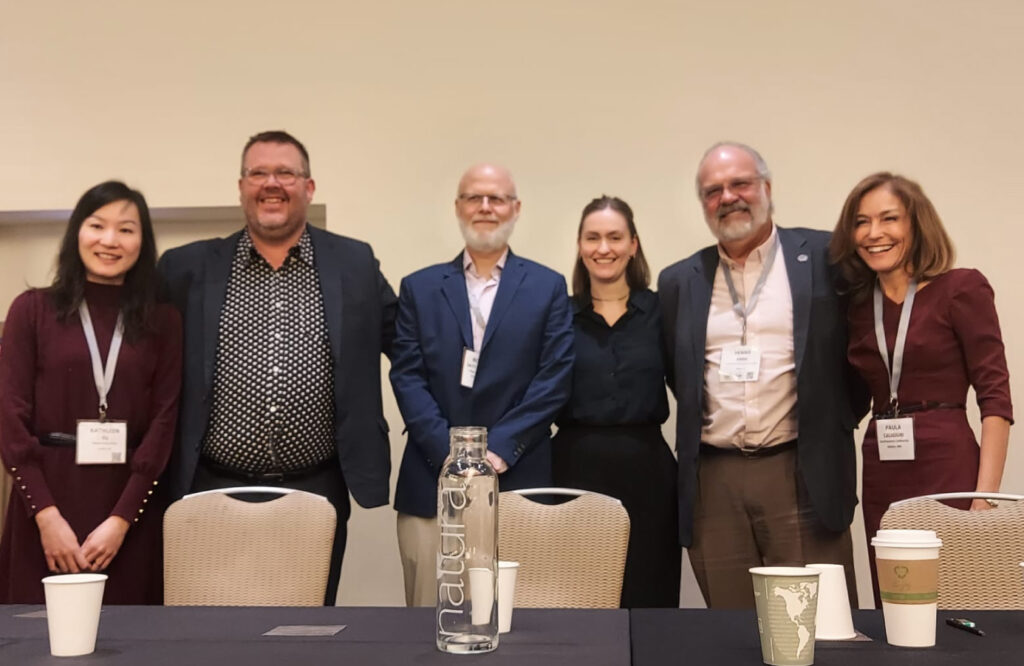Article · 6 minute read
Four Perspectives on Leadership Potential
SIOP Conference 2024: Alternative Approaches to Leadership Potential in Talent Management
By Lauren Jeffery-Smith – 3rd May 2024
I had the pleasure of speaking at my first Society for Industrial and Organizational Psychology Conference last month in Chicago, which is attended by literally thousands of IO psychologists from across the world.
Our “mashup” session on Alternative Approaches to Leadership Potential in Talent Management brought together a dream team of collaborators from Odgers Berndtson, TTS-Top Talent Solutions, Saville Assessment and Morgan Philips Talent Consulting, expertly facilitated by Paula Caligiuri of Skiilify (also a Distinguished Professor of International Business at Northeastern University).
In this summary, I will provide a quick overview of the four different perspectives on leadership potential we presented. Given that there were over 20 sessions running concurrently, we were delighted to draw well over 100 people to listen to our approaches.

Paula kicked us off with an overview of why leadership potential remains one of the most critical concerns for organizations, and referenced a recent LinkedIn survey which showed that, unsurprisingly, leadership is still coming out as one of the most in-demand skills.
Robert Satterwhite of Odgers Berndtson talked about how performance is important, but that it will only take us so far. He referenced the Peter Principle which highlights that people tend to get promoted until they reach a level where they are no longer competent. He emphasized the importance of context in terms of organizational and team demands and how once the context is understood, you can bring potential into the equation.
Odgers Berndtson define potential in terms of leadership agility – Thinking Dexterity, Interpersonal Savvy, Growth Proficiency and Personal Spirit. Leaders who possess these attributes will have greater agility in the face of ambiguity and complexity. Robert finished by sharing an example scenario from a Harvard Business Review article (Fernández-Aráoz, Roscoe & Aramaki, 2017) of two candidates for a CEO position. When compared on current competency level, the first candidate was a closer match, but potential results indicated that the second candidate could develop beyond the first. Following a development program, this prediction was borne out and the second candidate was selected – this highlighted the importance of assessing a candidate’s potential.

Hennie Kriek of TTS then discussed whether leadership assessment should emphasize the identification of potential or experience. He talked through the different terms that have been used over the years, often interchangeably, such as competencies, competences, capabilities, KSAOs and one of the key words of the conference as a whole – skills.
He described the three aspects that are integral to leadership assessment – backward-looking experiences and attainments (qualifications, experience, skills, knowledge), forward-looking dispositions and characteristics (abilities, personality, motivation, values) and foundational characteristics and factors (emotional intelligence, leadership stability, growth potential, motivations). These factors combine to form the TTS Capabilities Framework.
Hennie concluded that combining backward- and forward-looking assessments with foundational characteristics means organizations can better predict and develop future leaders, and highlighted the importance of taking a holistic approach to leadership assessment which has the potential to enhance overall effectiveness in predicting job success.

I was up next and began by explaining how traditional models of potential can be restrictive as they tend to only present a single definition that applies to all leadership across all organizations. This can mean individuals only see one type of career path in an organization. I outlined the development process we undertook to create a framework (see below) of Core Leadership Potential with three Leadership Career Path Indicators – Operational, People and Strategic Leadership. This development approach aimed to maximize both validity and fairness for protected groups.
Core Leadership Potential
Individuals with strong Core Leadership potential will be those most likely to successfully lead the organization and its people.
Operational Leadership
Individuals with strong Operational Leadership potential are likely to be effective at driving the development of specialist expertise and delivery capabilities through a systematic and analytical approach.
People Leadership
Individuals with strong People Leadership potential are likely to be effective at inspiring others and bringing people together to successfully work towards a common goal.

Strategic Leadership
Individuals with strong Strategic Leadership potential are likely to be effective at targeting growth by challenging how things are done, driving innovation and leading change.
This approach of combining core leadership potential with career path indicators adds another dimension over traditional approaches to potential, by avoiding a simple binary labelling of individuals as either high-potential or low-potential. Individuals who may not be high-potential in a more general, overall sense typically still have a clear career path they are more suited to, which gives them something to work towards and focus their career development on.
In addition to it being important to help the individual understand and develop into their career path, it is also valuable to help organizations understand their leadership pipeline and to more effectively manage their talent. The addition of the three career path areas widens the opportunities for progression outside of what is often an exclusive high-potential cohort. Career tracks are laid for everyone, whether they are identified as having general high potential or not.
Our approach to feedback in the context of leadership potential is two-fold – providing advice on areas which would be useful generally to develop and highlighting where individuals can focus their development to maximize their progression in a particular career path.
Everyone has the potential to develop and thrive in a career area which aligns with their strengths.
Rather than thinking of each individual as being high- or low-potential, everyone has the potential to develop and thrive in a career area which aligns with their strengths.
Organizations are looking for approaches that go beyond simply identifying high-potential individuals. While these high-potential employees may be singled out for special attention, for example in accelerated development programs, the question remains how to develop key talent who may not aspire or be suited to fast career progression to top leadership positions. The addition of career path indicators and targeted development advice against these provides a solution to develop potential more broadly across the organization

Finally, Kathleen Yu of Morgan Philips Talent Consulting took to the podium to discuss the development of an agility model to assess leadership potential. She outlined their approach of using agility as a measurement of leadership potential in response to the pace of change requiring a different kind of talent who can sense and respond (rather than plan and predict). Morgan Philips Talent Consulting define agility as “the ability to work with insight, flexibility and confidence in response to challenging and changing circumstances” and split this into People, Performance and Growth agility.
She outlined a criterion-related validation study using development centre (DC) results as an indicator of future leadership potential. Participants with higher agility scores had higher DC scores (significant based on a one-way ANOVA). She concluded that the agility assessment provides a proven measure of leadership potential that can be used standalone or in combination with other frameworks.
Paula wrapped up by summarizing the key takeaways from each presentation and emphasizing the importance of the different perspectives, then we rounded off the session with the panel taking questions from the audience. It was a brilliant opportunity to collaborate and connect with our colleagues in the IO psychology community!
Find Out More
Our team will be happy to tell you more about any of the themes discussed and how tools can help you uncover leadership potential in your organization.
About the Author
Lauren Jeffery-Smith
Lauren is Wave Portfolio Manager at Saville Assessment and has over a decade of experience developing assessment solutions. She has presented at numerous industry conferences including the European Association of Work and Organizational Psychology, International Test Commission and British Psychological Society Division of Occupational Psychology.
You can connect with Lauren on LinkedIn here.
